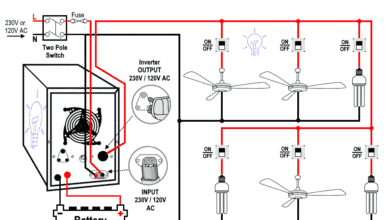What is the Suitable Wire Size for 20A Breaker and Outlet?
How to Find the the Right Wire Size for a 20-Amp Breaker and Outlet Based on NEC?
Choosing the the suitable wire size for a 20-ampere (20A) breaker and outlet is important for safety, circuit protection, and the proper operation of the device. The National Electrical Code (NEC) – NFPA 70 provides guidelines to ensure that electrical systems are safe, functional, and compliant with national standards. This article outlines the requirements and considerations for selecting the appropriate wire size for a 20A breaker and outlet according to NEC guidelines.
- Related Post: What is the Right Wire Size for 15A Breaker and Outlet?
Why is the Correct Wire Size Important?
Using the correct wire size for a breaker, outlet, and load points is essential for several reasons: safety, efficiency, code compliance, longevity, and durability.
Correct wire sizing prevents overheating, insulation damage, and fire hazards, minimizes voltage drop, and enhances the longevity of the electrical system. The suitable wire size also prevents premature insulation degradation, reduces the risk of frequent breaker trips and electrical faults, and ensures compliance with NEC 2020, IEC, and IEEE regulations to avoid potential liabilities and inspection issues. The right wire size ensures devices receive the proper voltage for efficient operation.
It is important to consider the breaker rating, load current, ampacity, type of wire and insulation, voltage drop, distance, and ambient temperature before selecting the right wire size for a breaker, outlet, and load applications.
If you are unsure about wiring installations, consult a licensed electrician to ensure compliance with local area codes.
What is the Suitable Wire Size for a 20A Breaker and Outlet?
Based on NEC Table 310.15(B)(16) (formerly Table 310.16), the standard wire size for a 20-ampere breaker is 12 AWG copper wire. A 12 gauge (AWG) copper wire can handle:
- 20 amps at 60°C (140°F)
- 25 amps at 75°C (167°F)
- 30 amps at 90°C (194°F)
In the case of aluminum, the recommended wire size with a 20A breaker and outlet is 10 AWG. The ampacity of a #10 AWG aluminum is:
- 25 amps at 60°C (140°F)
- 30 amps at 75°C (167°F)
- 35 amps at 90°C (194°F)
If you are going to wire and install a 20A breaker with a 20A outlet, then:
- It is recommended to use copper wire instead of aluminum wire.
- It is recommended to use solid wire rather than stranded wire.
- Most US homes are wired using solid wire instead of stranded wire.
According to the NEC – 310-16, add 20% of additional ampacity for every 100 feet (30.50 meters) of distance (for example between main panel and subpanel) to counter the voltage drop.
How to Select the Right Wire Size for a 20A Breaker and Outlet?
The label printed on the device (i.e. water heater or air-condition in HVAC) shows the minimum circuit ampacity (MCA) and maximum overcurrent protect (MOCP). MCA is the amount of minimum load current the circuit will draw while the MOCP shows the recommended fuse or breaker rating with the desired appliance or device.
Suppose you have a 2-pole, 20A breaker installed in the main panel, and you want to wire it to a 20A outlet or load circuit. Follow these steps to find the correct wire size according to the NEC, which is based on the breaker, not the outlet or load circuit.
Example:
If the Load is Continuous
The 125% rule (also known as the continuous load rule) in the NEC states that the OCPD (Overcurrent Protection Device i.e. fuse or breaker) size should handle 125% of the continuous load. As a safety factor, only 80% of the continuous load should be connected to the rated breaker.
20A × 80% = 16A
This shows that only 16A of continuous load should be connected to the 20A breaker. The same applies to a 20A outlet.
As the load circuit amperes are 16A, to find the breaker size for this circuit:
16A × 125% = 20A
According to NEC Table 310.15(B)(16), the 12 AWG wire size can carry 20A at 60°C (140°F) and 25A at 75°C (167°F).
If the Load is Non-continuous
For non-continuous loads (e.g., lighting circuits), the conductor size should be no less than 100%. The same applies to overcurrent protection devices (OCPDs).
Hence, a 20A breaker can be used for a maximum of 20A circuits (e.g., outlets) while considering the ambient temperature rating [Refer to 110.14(C) and 310.15(B)(2)].
-
Good to Know: Always consider the voltage drop in long distance circuits and ambient temperature when selecting the wire size.
How Many Amps Can a 20A Breaker Handle Safely?
The maximum current-handling capacity of a 20-amp breaker is 20A. According to the 125% safety factor, only 80% of the branch circuit load should be connected to the circuit:
20A × 80% = 16A
While it can handle up to 20A of non-continuous load, only 16A max of continuous load circuit should be connected to a 20A breaker and outlet. i.e.:
- Use a 20A breaker and outlet for a 16A continuous load circuit.
- Use a 20A breaker and outlet for a 20A non-continuous load circuit.
The rating of the breaker and outlet, and the ampacity of the wire size, comply with the National Electrical Code (NEC) – Sections 210.19(A), 215.2, and 230.42(A) for continuous and non-continuous loads, and 110.14(C) for ambient temperature.
The above calculations are based on NEC Table 310.15(B)(16) and 240.4(A) through (G), illustrating that the 12 AWG wire size can carry 20A at 60°C (140°F) and 25A at 75°C (167°F).
How Many Watts Can a 20-Amp Breaker and Outlet Hold?
120V Circuit
In a 120V circuit, a 1-P, 20-amp breaker holds a maximum of 2,400 watts:
20A × 120V = 2,400 watts
If we apply the safety factor of 80% of the load to a rated breaker and outlet:
20A × 80% = 16A
Hence, no more than 1,920 watts of load should be connected to a 20A breaker and outlet:
16A × 120V = 1,920 watts
As an example load, you may use 20A breaker in 120V circuit with 1.5kW to 1,700 Watts water heater element.
-
Good to know: A 1-pole, 20A breaker in 120V circuit can be connected to the associated outlets such as NEMA 2-20R, 5-20R, 10-20R or 14-20R etc.
240V Circuit
In a 240V single-phase AC circuit, a 20-amp breaker holds a maximum of 4,800 watts:
20A × 240V = 4,800 watts
Applying the safety factor of 80% of the load to a rated breaker and outlet:
20A × 80% = 16A
Based on the above calculation, no more than 3,840 watts of load having 16A of current should be connected to a 20A breaker and outlet:
16A × 240V = 3,840 watts
For example, you may use 20A breaker with 240V, 3kW, 3.5kW or 3.8kW water heater element.
Based on the above calculations, A 20A breaker and outlet can handle a maximum of 2,400W and safely 1,920W in a 120V circuit, while it can handle a maximum of 4,800W and safely 3,840W in a 240V circuit.
-
Good to know: A 2-pole, 20A breaker in 240V circuit can be wired for the rated outlets such as NEMA 2-20R, 6-20R, 10-20R, 14-20R etc.
How Many Outlets Can be Installed on a 20A Breaker?
A 20-amp circuit can support around 10 outlets, assuming a maximum 1.5 amp draw per outlet. However, the exact number depends on the electrical load, not the number of outlets.
The National Electrical Code (NEC) recommends limiting circuit loads to 80% of their maximum capacity for continuous use. This means a 20-amp circuit, which can handle 2,400 watts, should be limited to 1,920 watts or 16 amps:
20A × 80% = 16A
16A × 120V = 1,920 Watts … (in 120V circuits)
16A × 240V = 3,840 Watts … (in 240V circuits)
Dividing 16 amps by 1.5 amps per outlet gives an estimate of 10.67 outlets, which rounds down to 10.
However, this is a theoretical maximum and not recommended in practice to avoid overloading. For more details, refer to the NEC table – 210.21(B)(3) for receptacles rating for various size circuits which clarify the circuit rating and receptacle rating in amperes.
Can I Use a #10 AWG or 14 AWG Instead of #12 AWG Copper Wire on a 20-Amp Breaker?
#10 AWG Instead of #12 AWG:
According to the NEC, using #10 AWG instead of #12 AWG on a 20A breaker is permissible because #10 AWG wire can handle 30A at 60°C (140°F) and 35A at 75°C (167°F). While doing so, this approach might not be cost-effective, and the larger wire may not fit into the terminals of some 20-amp devices or fixtures.
#14 AWG Instead of #12 AWG:
Using #14 AWG instead of #12 AWG on a 20A breaker is against the code and not recommended. The #14 AWG wire can handle only 15A at 60°C (140°F). Using a lower ampacity wire size with a higher rated breaker may overheat the wire, leading to fire hazards and circuit damage.
What Happens If the Wrong Wire Size is Used with a Breaker?
If you use a smaller wire gauge than recommended (e.g., using 14 or 16 AWG with a 20A breaker, which is against the code), it might overheat, increase the voltage drop, and trip the breaker. This scenario may also lead to insulation failure, which can cause a serious fire and electric shock.
If you use a larger wire gauge than recommended (e.g., using 8 or 10 AWG with a 20A breaker), you will need larger conduits for the larger wires and may face difficulty in installation because thicker wires may not fit in the fixtures and outlets. It also increases the initial cost because larger gauge wires are more expensive.
What Happens if a 14 AWG Wire is Connected to a 20A Breaker?
Connecting a 14 AWG wire to a 20A breaker is unsafe. The 14 AWG wire is rated for 15A, not 20A. This can cause:
- Overheating: 14 AWG wire may overheat under a 20A load.
- Fire Hazard: Increased risk of fire due to overheating.
- Code Violation: Non-compliance with NEC standards.
Using the correct wire size is essential for safety, efficiency, and code compliance. For a 20A breaker, use 12 AWG copper wire or 10 AWG aluminum wire to ensure your electrical system operates safely and reliably. If in doubt, consult a licensed electrician to ensure compliance with local codes and standards.
Suitable Types of Cables for a 20A Breaker and Outlet
The following types of wires and cables are suitable with 20A breaker and outlet.
In the case of copper wire:
- NM-B (Non-Metallic Sheathed Cable), known as ROMEX
- MC (Metal-Clad Cables)
- THHN/THWN
- UF-B
In the case of aluminum wire:
- USE for underground service
- SE for service entrance
Applications of a 20A Breaker and 20A Outlet
Common residential and commercial applications of 20A breakers and 20A outlets include:
- Kitchen appliances
- Bathrooms
- Laundry rooms
- Power tools
- Workshops and garages
- Home offices
- Heating and cooling systems (HVAC)
- Outdoor equipment
- Dedicated circuits
Good to Know:
Resources:
- What is the Right Wire Size for a 4.8kW, 240V Range: #10 or #12?
- How to Find the Right Wire Size for 100 Amp in AWG?
- How to Size a Load Center, Panelboards and Distribution Board?
- How to Determine the Number of Circuit Breakers in a Panelboard?
- How to Find the Proper Size of Circuit Breaker? Breaker Size Calculator & Examples
- How to Find The Suitable Size of Cable & Wire for Electrical Wiring Installation? (Metric & Imperial Systems)
- How to Find Voltage & Ampere Rating of Switch, Plug, Outlet & Receptacle
- American Wire Gauge “AWG” Chart – Wire Size & Ampacity Table
- American Wire Gauge “AWG” Calculator – AWG Size Chart & Table
- Standard Wire Gauge “SWG” Calculator – SWG Size Chart & Table
- AWG/SWG to mm/mm2, inch/inch2 & kcmil Calculator & Conversion
- How to Wire 120V & 240V Main Panel? Breaker Box Installation
- How to Wire a Subpanel? Main Lug Installation for 120V/240V
- How to Wire a GFCI Circuit Breaker?
- How to wire a GFCI Outlet?
- How to Wire an AFCI Breaker?
- How to Wire an AFCI Outlet?
- How to Wire an Outlet Receptacle? Socket Outlet Wiring Diagrams
- Wire and Cable Size Calculator in AWG
- Electrical Wire and Cable Size Calculator (Copper & Aluminum)







